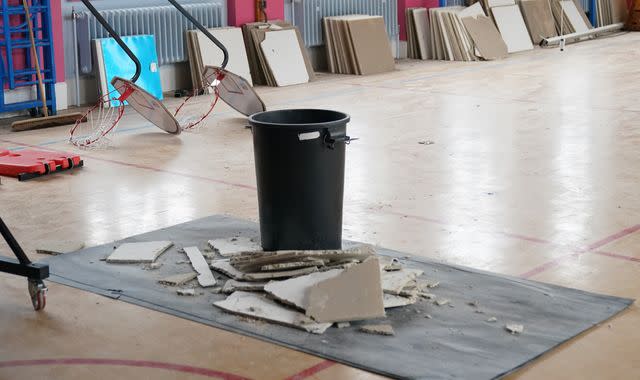School closures over concrete safety: How will I know if my child's school is shutting? What the government has revealed so far

As schools welcome pupils back for the start of term, some are grappling with sudden disruption and closure caused by fears about the safety of concrete used in buildings.
The type of concrete forcing the closures is reinforced autoclaved aerated concrete, known as RAAC.
It is the same type of concrete that has been found in some hospitals that have been deemed to be unsafe, prompting Health Secretary Steve Barclay to fast-track them into the government's hospitals-building programme.
Here's what we know so far.
How will I know if my child's school is closing?
Sky News is compiling a list of all the schools known to be affected.
Schools and other education settings will let parents know directly if there is any change to the start of term.
More than 150 schools and other education settings are affected. About 50 have already been disrupted this year and a further 104 were added to the list on Thursday.
The government has not released a list of the schools. Ministers have promised to publish a list of the schools affected "in due course" but Labour has threatened to force a vote to compel its publication next week.
More classrooms could be forced to shut as further assessments are made of the risks, the government has admitted.
If my child's school is affected, will it need to close?
Not all schools that use RAAC in their buildings need to close.
Some may just have the concrete in one building, for example, resulting in the closure of a small number of classrooms.
Others may be able to continue education with very little disruption if the concrete is in a small enough area.
"In most cases, children will be able to continue attending school as normal," the Department for Education (DfE) said.
But the number of schools that will have to shut completely is not yet known, Mr Gibb told Sky News on Friday morning.
What will happen in affected schools?
Where RAAC has been used in school buildings, affected areas will be taken out of use.
Guidance issued to schools said they should find emergency or temporary accommodation for the "first few weeks" until buildings are made safe with structural supports.
All affected schools will be assigned a dedicated DfE caseworker, who will help assess the site's needs and put solutions in place.
This could include using other on-site buildings or local spaces, putting in place safety measures in the affected area and, in some cases, erecting temporary buildings.
Schools and colleges are still expected to deliver "face-to-face, high-quality education to all pupils and students other than in exceptional circumstances", the DfE said.
Read more:
Schools face closure over concrete safety fears
Return of remote learning should last 'days, not weeks'
Ministers told to 'get a grip' on unsafe concrete
Will schools switch to remote learning?
Pandemic-style remote learning is a last resort that should only be used for short periods, the government has told schools.
"It should only be used where all options to continue face-to-face education - either on your site, at an alternative, or in temporary accommodation - have been exhausted," the DfE said.
If schools do need to use remote learning, the work should be "high quality, meaningful, ambitious and cover an appropriate range of subjects", the department added.
What if my child can't stay at their current school?
In some cases, pupils may be moved to emergency or longer-term temporary accommodation on a different school site.
This would be arranged by the school or college alongside the local authority.
If this happens, they should be able to stay on the roll of their normal school.
Is your child's school one that has been forced to close over unsafe concrete fears?
Share your story with us on WhatsApp here.
By sending us your video footage, photographs or audio you agree we can publish, broadcast and edit the material.

 Yahoo News
Yahoo News 
